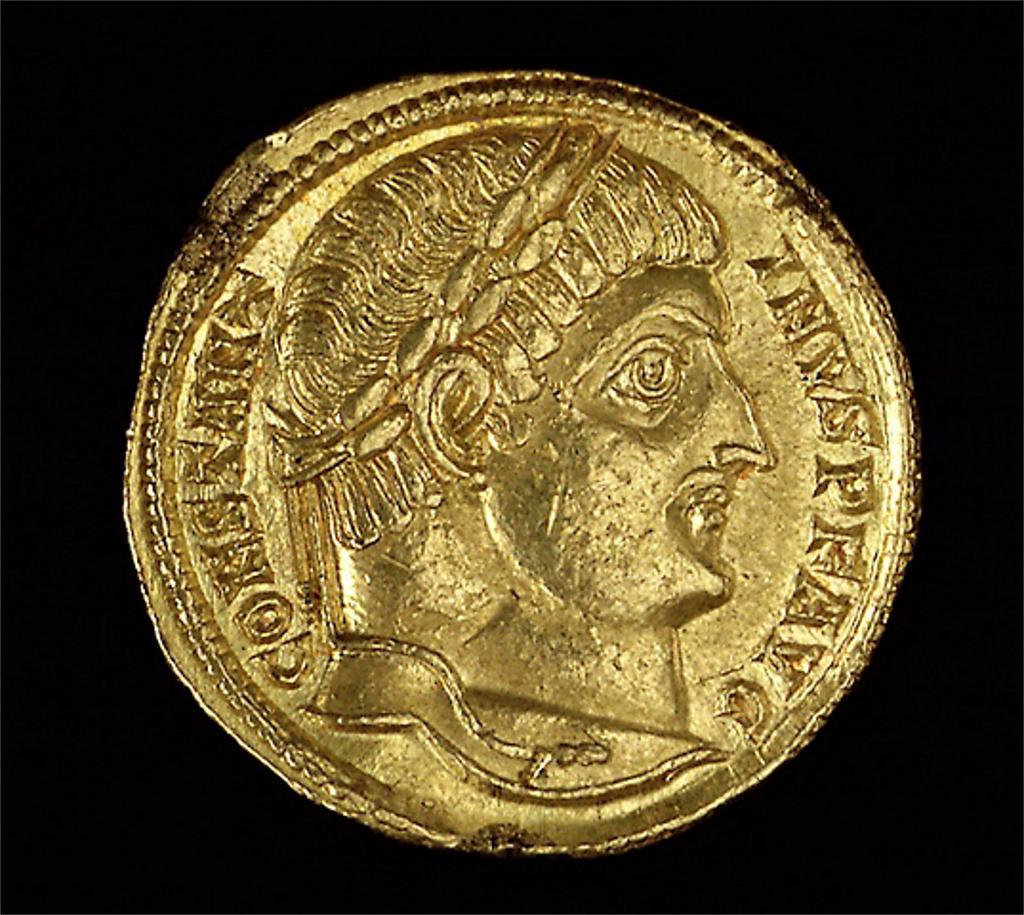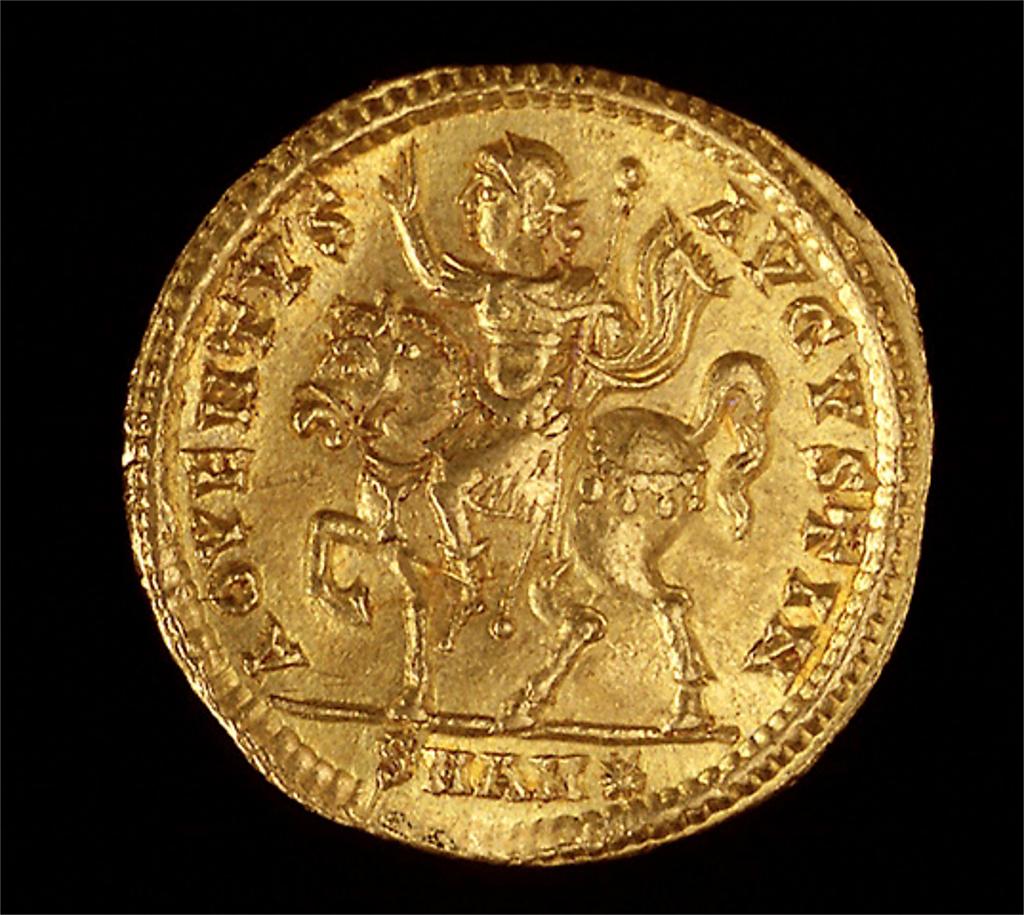On 29 October 312, Constantine the Great entered Rome after his victory at the Battle of the Milvian Bridge. Constantine was met with popular jubilaition and a grand adventus was held in the city. The body of the defeated Maxentius was fished out of the Tiber and posthumously beheaded.
Constantine succeeded his father Constantinus Chlorus (293-306) as co-emperor in 306. With the defeat of his longtime rival Maxentius he became sole ruler in the West. In 313, with Licinius (307–24), the Eastern Emperor, he published the Edict of Milan, which openly favored Christianity. Constantine defeated Licinius at the Battle of Chrysopolis in 324 and united the Empire under his control. Artistic and literary sources during his reign show an imperial policy dominated by the newly authorized religion, and new artistic values gradually transformed public art into a more fully recognizable Christian form. Constantine believed that his military successes were attributable to the Christian God, whose sign of the Cross had appeared to him, superimposed on the sun, at the Milvian Bridge. In the final battle he ordered the monogram of Christ to be painted on his soldiers’ shields, thus establishing the cross and the chi-rho in later iconography. His victory was commemorated in 315 with the construction of a triumphal arch in the Roman Forum.
Constantine was a patron mainly of architecture, particularly of churches. His most important undertaking was the foundation of a new capital, Constantinople (now Istanbul), which was begun in 324 and dedicated in 330. Many of the traditional features of Rome were reproduced, including a central forum, a senate house, an imperial palace and a main street, called the Mese. The churches sponsored by Constantine outside Constantinople included both martyria and city cathedrals. among the former was the basilica of Old St Peter’s, which was built to house the Apostle’s shrine and serve as a funeral hall. Two of the best-known cathedrals founded by the Emperor are the Basilica Constantiniana, now the basilica of S Giovanni in Laterano, and the double cathedral of Trier, Germany. an innovation of the period was the frieze sarcophagus, which had a forerunner in the Etruscan burial tradition.
Piero della Francesca’s Constantine’s Dream, part of the fresco cycle of the Legend of the True Cross (c. 1452–66; Arezzo) is an embellishment of the legend of Constantine’s vision at the Milvian Bridge.
The 29thof October was a significant date in other ways for Roman Byzantium. In 437, Valentinian III, Western Roman Emperor, married Licinia Eudoxia, daughter of his cousin Theodosius II, Eastern Roman Emperor in Constantinople, unifying the two branches of the House of Theodosius. In 969 Byzantine troops overran and occupied Antioch, then part of Syria. Its ruins are now part of southern Turkey.
Reference: “Constantine the Great.” In The Grove Encyclopedia of Medieval Art and Architecture. Oxford University Press, 2012. http://www.oxfordreference.com/view/10.1093/acref/9780195395365.001.0001/acref-9780195395365-e-620.
Roman Basilica of Maxentius and Constantine (Basilica Nova), 306-312 Photo: Loren Partridge.
Roman early Christian Mosaic (detail), c 400. The Archive for Research on Archetypal Symbolism, Nr. 28508.
Red porphyry sarcophagus of Constantina, daughter of Constantine the Great, c. 400. Rome, The Vatican Museum, Nr. 5Ac.006c. Found at Gunderstrup, Jutland, Denmark, 1891.
Gold fragment of a Cruciform Fibula inscribed with the Name of Emperor Constantine the Great (Elément de fibule cruciforme célébrant le dixième anniversaire de règne de l’empereur Constantin en 315 après J.-C.), 315. Musée du Louvre/Réunion des Musées Nationaux, Nr. BJ 947. Photographer: Hervé Lewandowski.
Constantine’s Column, erected ca. 330. Istanbul, Turkey. The column commemorates the declaration of Byzantium (Nova Roma) as the new capital city of the Roman Empire. The column is located on Yeniceriler Caddesi in central Istanbul, between Sultanahmet and Beyazit Square. Shmuel Magal, Sites and Photos.
Coin Showing Emperor Constantine the Great and Constantine on Horseback, c. 324-325. The Art Institute of Chicago, Nr. AIC_.1922.4903
Piero della Francesca, Legend of the True Cross: Constantine’s Dream, c. 1452. Church of San Francesco – Arezzo.
Further Reading: Elizabeth Hartley. Constantine the Great: York’s Roman Emperor. York: York Museums and Gallery Trust, 2006.







